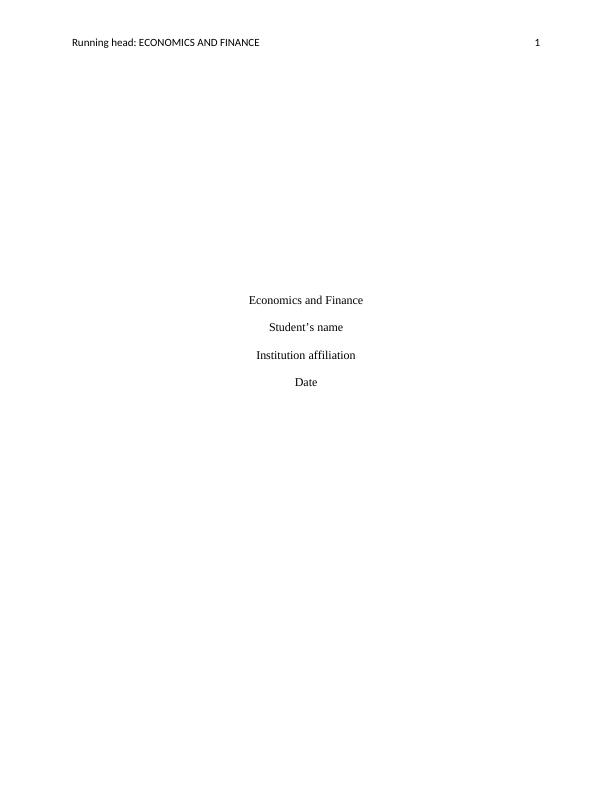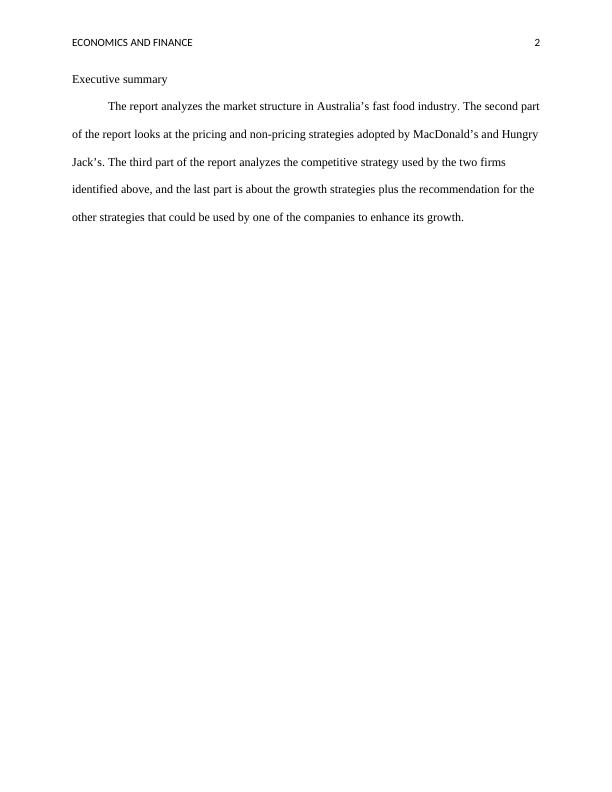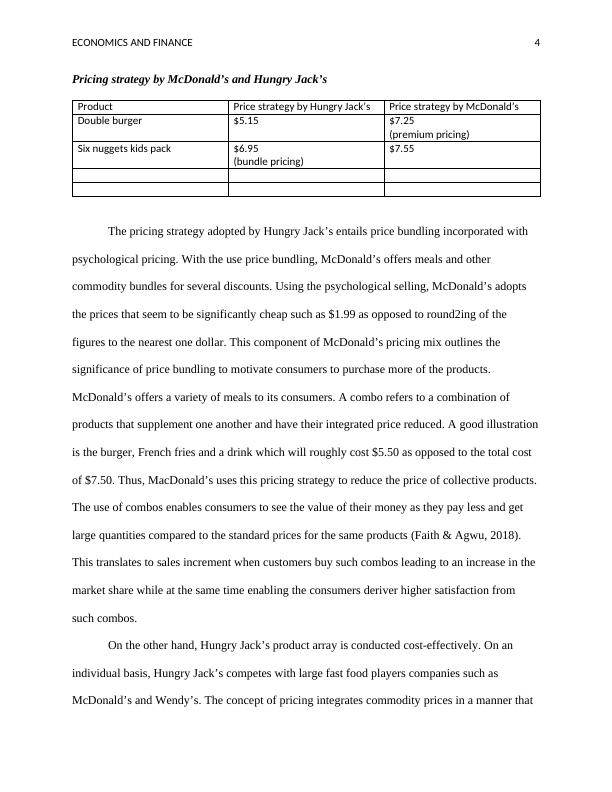Market Structure and Competitive Strategies in Australia's Fast Food Industry
Added on 2023-03-20
14 Pages3456 Words55 Views
Running head: ECONOMICS AND FINANCE 1
Economics and Finance
Student’s name
Institution affiliation
Date
Economics and Finance
Student’s name
Institution affiliation
Date

ECONOMICS AND FINANCE 2
Executive summary
The report analyzes the market structure in Australia’s fast food industry. The second part
of the report looks at the pricing and non-pricing strategies adopted by MacDonald’s and Hungry
Jack’s. The third part of the report analyzes the competitive strategy used by the two firms
identified above, and the last part is about the growth strategies plus the recommendation for the
other strategies that could be used by one of the companies to enhance its growth.
Executive summary
The report analyzes the market structure in Australia’s fast food industry. The second part
of the report looks at the pricing and non-pricing strategies adopted by MacDonald’s and Hungry
Jack’s. The third part of the report analyzes the competitive strategy used by the two firms
identified above, and the last part is about the growth strategies plus the recommendation for the
other strategies that could be used by one of the companies to enhance its growth.

ECONOMICS AND FINANCE 3
Introduction
MacDonald’s began its operations in 1940 as a barbeque restaurant and was founded by
then by both Richard and Maurice McDonald (McDonald's, 2019). It is since then that it has
transformed to become one of the leading fast food restaurants in Australia since 1948. With the
use of franchising model, MacDonald’s has expanded internationally becoming the largest fast-
food chain globally and operates more than 36000 franchises that are comprised of both the
small and medium restaurants with a presence in more than 115 nations (McDonald's, 2019). It
has been reported that McDonald’s serves hamburgers to roughly 68 million customers daily
internationally. Since 1971, when MacDonald’s ventured the Australian market for food with the
fast joint situated in Yagoona, it has seen more than 900 restaurants with the inclusion of both
the franchisees and fully-owned ones erected with more than 90,000 workers. The Burger King,
on the other hand, had its origins in Florida. The Burger King was, unfortunately, unable to use
its brand in Australia as another takeaway outlet in Adelaide had trademarked the brand was
during this time that saw Hungry Jack’s brand initiated with the first store situated in Inn aloo in
1971.
Pricing and non-pricing strategies by MacDonald’s and Hungry Jack’s
The use of pricing and non-pricing strategy helps a company gain a significant share with
regards to the sales and market (Davcik & Sharma, 2015). The pricing strategies entail cutting
the price to increase the level of sales and share of the market. The non-price strategy, on the
other hand, involves utilizing a variety of strategies that do not affect the price. Non-Price
strategy can be classified into two main segments. One is the product differentiation, which
involves changing the appearance of the commodity and product variation entails changing the
commodity.
Introduction
MacDonald’s began its operations in 1940 as a barbeque restaurant and was founded by
then by both Richard and Maurice McDonald (McDonald's, 2019). It is since then that it has
transformed to become one of the leading fast food restaurants in Australia since 1948. With the
use of franchising model, MacDonald’s has expanded internationally becoming the largest fast-
food chain globally and operates more than 36000 franchises that are comprised of both the
small and medium restaurants with a presence in more than 115 nations (McDonald's, 2019). It
has been reported that McDonald’s serves hamburgers to roughly 68 million customers daily
internationally. Since 1971, when MacDonald’s ventured the Australian market for food with the
fast joint situated in Yagoona, it has seen more than 900 restaurants with the inclusion of both
the franchisees and fully-owned ones erected with more than 90,000 workers. The Burger King,
on the other hand, had its origins in Florida. The Burger King was, unfortunately, unable to use
its brand in Australia as another takeaway outlet in Adelaide had trademarked the brand was
during this time that saw Hungry Jack’s brand initiated with the first store situated in Inn aloo in
1971.
Pricing and non-pricing strategies by MacDonald’s and Hungry Jack’s
The use of pricing and non-pricing strategy helps a company gain a significant share with
regards to the sales and market (Davcik & Sharma, 2015). The pricing strategies entail cutting
the price to increase the level of sales and share of the market. The non-price strategy, on the
other hand, involves utilizing a variety of strategies that do not affect the price. Non-Price
strategy can be classified into two main segments. One is the product differentiation, which
involves changing the appearance of the commodity and product variation entails changing the
commodity.

ECONOMICS AND FINANCE 4
Pricing strategy by McDonald’s and Hungry Jack’s
Product Price strategy by Hungry Jack’s Price strategy by McDonald’s
Double burger $5.15 $7.25
(premium pricing)
Six nuggets kids pack $6.95
(bundle pricing)
$7.55
The pricing strategy adopted by Hungry Jack’s entails price bundling incorporated with
psychological pricing. With the use price bundling, McDonald’s offers meals and other
commodity bundles for several discounts. Using the psychological selling, McDonald’s adopts
the prices that seem to be significantly cheap such as $1.99 as opposed to round2ing of the
figures to the nearest one dollar. This component of McDonald’s pricing mix outlines the
significance of price bundling to motivate consumers to purchase more of the products.
McDonald’s offers a variety of meals to its consumers. A combo refers to a combination of
products that supplement one another and have their integrated price reduced. A good illustration
is the burger, French fries and a drink which will roughly cost $5.50 as opposed to the total cost
of $7.50. Thus, MacDonald’s uses this pricing strategy to reduce the price of collective products.
The use of combos enables consumers to see the value of their money as they pay less and get
large quantities compared to the standard prices for the same products (Faith & Agwu, 2018).
This translates to sales increment when customers buy such combos leading to an increase in the
market share while at the same time enabling the consumers deriver higher satisfaction from
such combos.
On the other hand, Hungry Jack’s product array is conducted cost-effectively. On an
individual basis, Hungry Jack’s competes with large fast food players companies such as
McDonald’s and Wendy’s. The concept of pricing integrates commodity prices in a manner that
Pricing strategy by McDonald’s and Hungry Jack’s
Product Price strategy by Hungry Jack’s Price strategy by McDonald’s
Double burger $5.15 $7.25
(premium pricing)
Six nuggets kids pack $6.95
(bundle pricing)
$7.55
The pricing strategy adopted by Hungry Jack’s entails price bundling incorporated with
psychological pricing. With the use price bundling, McDonald’s offers meals and other
commodity bundles for several discounts. Using the psychological selling, McDonald’s adopts
the prices that seem to be significantly cheap such as $1.99 as opposed to round2ing of the
figures to the nearest one dollar. This component of McDonald’s pricing mix outlines the
significance of price bundling to motivate consumers to purchase more of the products.
McDonald’s offers a variety of meals to its consumers. A combo refers to a combination of
products that supplement one another and have their integrated price reduced. A good illustration
is the burger, French fries and a drink which will roughly cost $5.50 as opposed to the total cost
of $7.50. Thus, MacDonald’s uses this pricing strategy to reduce the price of collective products.
The use of combos enables consumers to see the value of their money as they pay less and get
large quantities compared to the standard prices for the same products (Faith & Agwu, 2018).
This translates to sales increment when customers buy such combos leading to an increase in the
market share while at the same time enabling the consumers deriver higher satisfaction from
such combos.
On the other hand, Hungry Jack’s product array is conducted cost-effectively. On an
individual basis, Hungry Jack’s competes with large fast food players companies such as
McDonald’s and Wendy’s. The concept of pricing integrates commodity prices in a manner that

End of preview
Want to access all the pages? Upload your documents or become a member.
Related Documents
McDonald’s and Hungry Jack’s: Competitive Strategies, Pricing, and Market Structurelg...
|10
|3434
|28
ECO600- Economics And Finance For Businesslg...
|18
|3443
|43
Economics and Finance for Businesslg...
|8
|3332
|55
Business Strategy for Hungry Jack's: Cost Leadership, Differentiation and Focuslg...
|15
|3576
|137
Market Competition Analysis for McDonald's and Hungry Jack's in Sydney Citylg...
|13
|3826
|423
Hungry Jacks: Marketing Analysis and New Product Recommendationlg...
|12
|3485
|447
